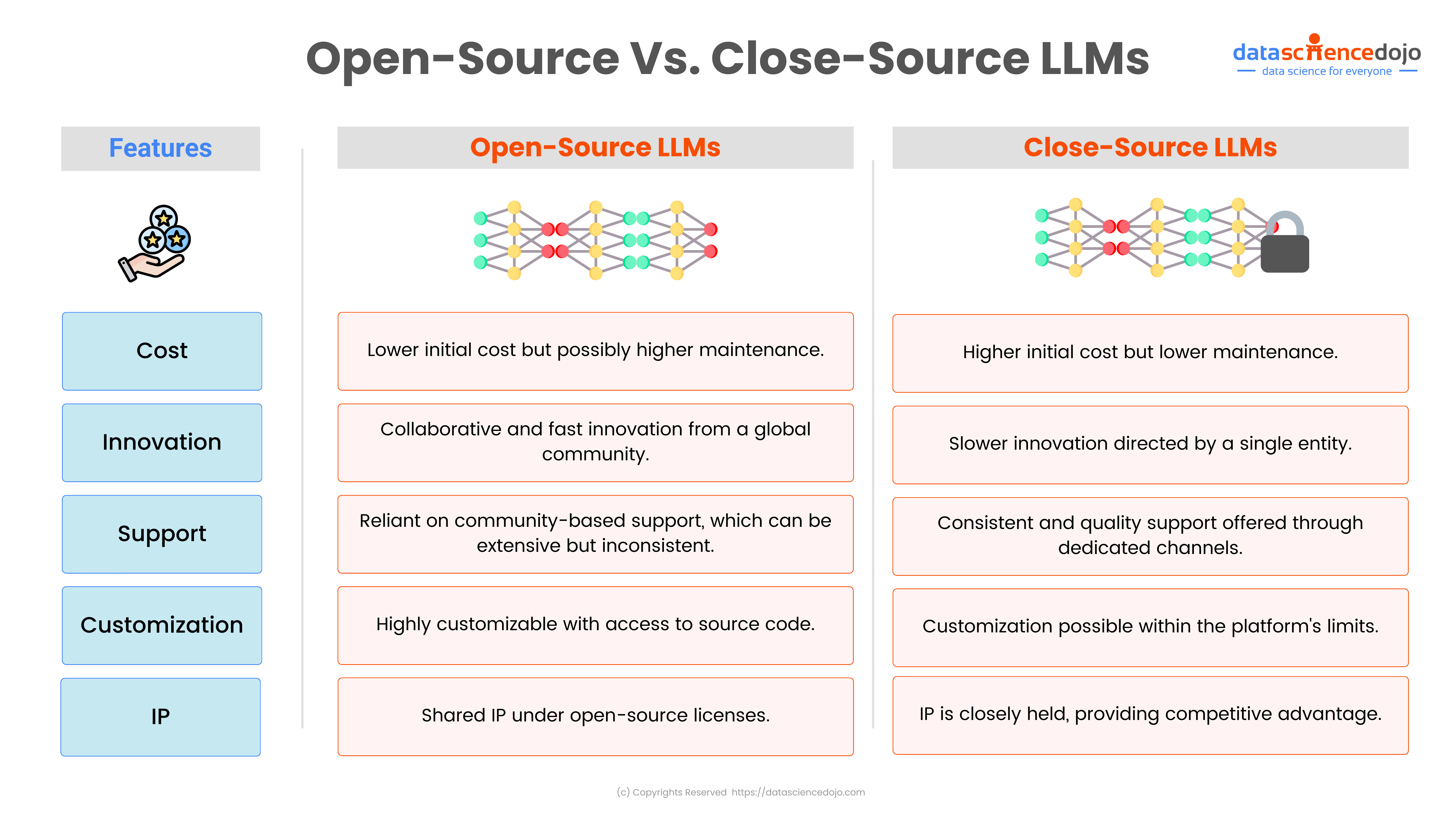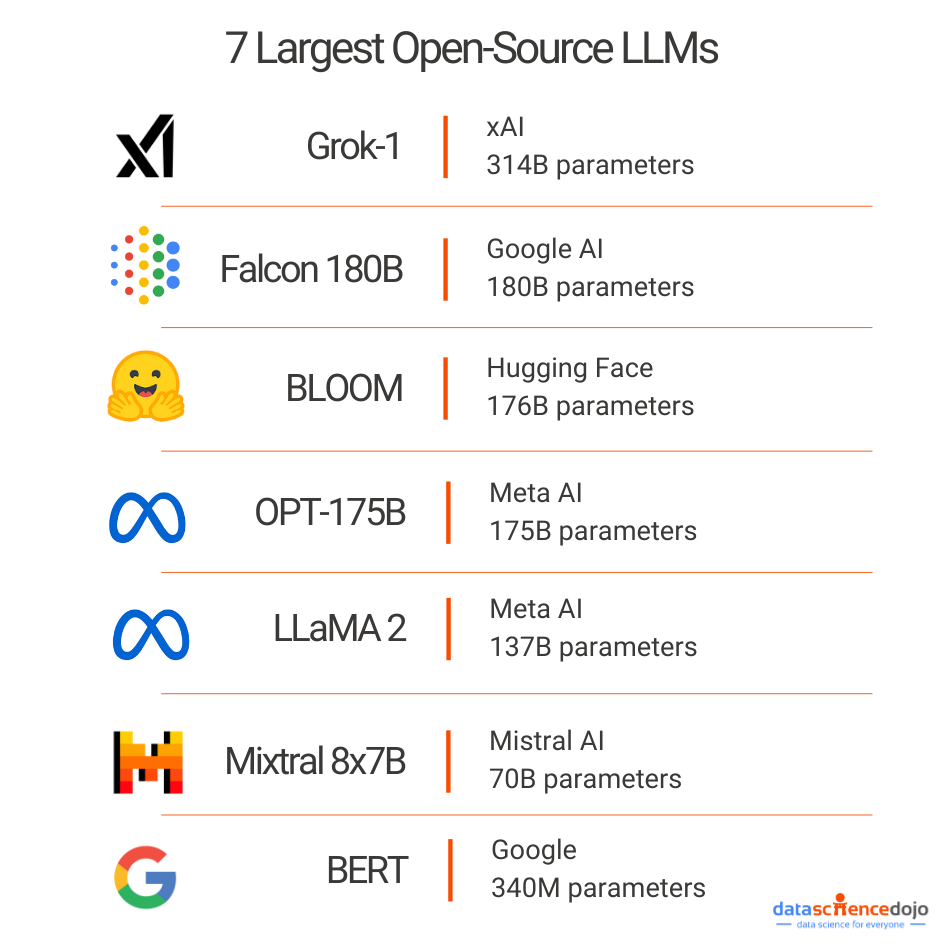Large Language Models have surged in popularity due to their remarkable ability to understand, generate, and interact with human language with unprecedented accuracy and fluency.
This surge is largely attributed to advancements in machine learning and the vast increase in computational power, enabling these models to process and learn from billions of words and texts on the internet.
OpenAI significantly shaped the landscape of LLMs with the introduction of GPT-3.5, marking a pivotal moment in the field. Unlike its predecessors, GPT-3.5 was not fully open-source, giving rise to closed-source large language models.
This move was driven by considerations around control, quality, and the commercial potential of such powerful models. OpenAI’s approach showcased the potential for proprietary models to deliver cutting-edge AI capabilities while also igniting discussions about accessibility and innovation.
The Introduction of Open-Source LLM
Contrastingly, companies like Meta and Mistral have opted for a different approach by releasing models like LLaMA and Mistral as open-source.
These models not only challenge the dominance of closed-source models like GPT-3.5 but also fuel the ongoing debate over which approach—open-source or closed-source—yields better results. Read more
By making their models openly available, Meta and similar entities encourage widespread innovation, allowing researchers and developers to improve upon these models, which in turn, has seen them topping performance leaderboards.
From an enterprise standpoint, understanding the differences between open-source LLM and closed-source LLM is crucial. The choice between the two can significantly impact an organization’s ability to innovate, control costs, and tailor solutions to specific needs.
Let’s dig in to understand the difference between Open-Source LLM and Closed Source LLM
What Are Open-Source Large Language Models?
Open-source large language models, such as the ones offered by Meta AI, provide a foundational AI technology that can analyze and generate human-like text by learning from vast datasets consisting of various written materials.
As open-source software, these language models have their source code and underlying architecture publicly accessible, allowing developers, researchers, and enterprises to use, modify, and distribute them freely.
Let’s dig into different features of open-sourced large language models
1. Community Contributions
-
Broad Participation:
Open-source projects allow anyone to contribute, from individual hobbyists to researchers and developers from various industries. This diversity in the contributor base brings a wide array of perspectives, skills, and needs into the project.
-
Innovation and Problem-Solving:
Different contributors may identify unique problems or have innovative ideas for applications that the original developers hadn’t considered. For example, someone might improve the model’s performance on a specific language or dialect, develop a new method for reducing bias, or create tools that make the model more accessible to non-technical users.
Discover how embeddings enhance open-source LLMs in our detailed guide here
2. Wide Range of Applications
-
Specialized Use Cases:
Contributors often adapt and extend open-source models for specialized use cases. For instance, a developer might fine-tune a language model on legal documents to create a tool that assists in legal research or on medical literature to support healthcare professionals.
-
New Features and Enhancements:
Through experimenting with the model, contributors might develop new features, such as more efficient training algorithms, novel ways to interpret the model’s outputs, or integration capabilities with other software tools.
3. Iterative Improvement and Evolution
-
Feedback Loop:
The open-source model encourages a cycle of continuous improvement. As the community uses and experiments with the model, they can identify shortcomings, bugs, or opportunities for enhancement. Contributions addressing these points can be merged back into the project, making the model more robust and versatile over time.
-
Collaboration and Knowledge Sharing:
Open-source projects facilitate collaboration and knowledge sharing within the community. Contributions are often documented and discussed publicly, allowing others to learn from them, build upon them, and apply them in new contexts.
Examples of Open-Sourced Large Language Models
- Meta’s LLaMA 2
- Bloom by Hugging Face
- Mixtral of Experts by Mistral
What Are Closed-Source Large Language Models?
Closed-source large language models, such as GPT-3.5 by OpenAI, embody advanced AI technologies capable of analyzing and generating human-like text through learning from extensive datasets.
Unlike their open-source counterparts, the source code and architecture of closed-source language models are proprietary, accessible only under specific terms defined by their creators. This exclusivity allows for controlled development, distribution, and usage.
For a deeper dive into the best large language models, check out our detailed guide here
Features of Closed-Sourced Large Language Models
1. Controlled Quality and Consistency
- Centralized development: Closed-source projects are developed, maintained, and updated by a dedicated team, ensuring a consistent quality and direction of the project. This centralized approach facilitates the implementation of high standards and systematic updates.
- Reliability and stability: With a focused team of developers, closed-source LLMs often offer greater reliability and stability, making them suitable for enterprise applications where consistency is critical.
2. Commercial Support and Innovation
- Vendor support: Closed-source models come with professional support and services from the vendor, offering assistance for integration, troubleshooting, and optimization, which can be particularly valuable for businesses.
- Proprietary innovations: The controlled environment of closed-source development enables the introduction of unique, proprietary features and improvements, often driving forward the technology’s frontier in specialized applications.
3. Exclusive Use and Intellectual Property
- Competitive advantage: The proprietary nature of closed-source language models allows businesses to leverage advanced AI capabilities as a competitive advantage, without revealing the underlying technology to competitors.
- Intellectual property protection: Closed-source licensing protects the intellectual property of the developers, ensuring that their innovations remain exclusive and commercially valuable.
4. Customization and Integration
- Tailored solutions: While customization in closed-source models is more restricted than in open-source alternatives, vendors often provide tailored solutions or allow certain levels of configuration to meet specific business needs.
- Seamless integration: Closed-source large language models are designed to integrate smoothly with existing systems and software, providing a seamless experience for businesses and end-users.
Examples of Closed-Source Large Language Models
Read: Should Large Language Models be Open-Sourced? Stepping into the Biggest Debates
Open-Source vs Closed-Source LLMs for Enterprise Adoption

In terms of enterprise adoption, comparing open-source and closed-source large language models involves evaluating various factors such as costs, innovation pace, support, customization, and intellectual property rights.
Costs
- Open-Source: Generally offers lower initial costs since there are no licensing fees for the software itself. However, enterprises may incur costs related to infrastructure, development, and potentially higher operational costs due to the need for in-house expertise to customize, maintain, and update the models.
- Closed-Source: Often involves licensing fees, subscription costs, or usage-based pricing, which can predictably scale with use. While the initial and ongoing costs can be higher, these models frequently come with vendor support, reducing the need for extensive in-house expertise and potentially lowering overall maintenance and operational costs.
Innovation and Updates
- Open-Source: The pace of innovation can be rapid, thanks to contributions from a diverse and global community. Enterprises can benefit from the continuous improvements and updates made by contributors. However, the direction of innovation may not always align with specific enterprise needs.
- Closed-Source: Innovation is managed by the vendor, which can ensure that updates are consistent and high-quality. While the pace of innovation might be slower compared to the open-source community, it’s often more predictable and aligned with enterprise needs, especially for vendors closely working with their client base.
Discover the top LLM use cases to enhance your understanding here
Support and Reliability
- Open-Source: Support primarily comes from the community, forums, and potentially from third-party vendors offering professional services. While there can be a wealth of shared knowledge, response times and the availability of help can vary.
- Closed-Source: Typically comes with professional support from the vendor, including customer service, technical support, and even dedicated account management. This can ensure reliability and quick resolution of issues, which is crucial for enterprise applications.
Customization and Flexibility
- Open-Source: Offer high levels of customization and flexibility, allowing enterprises to modify the models to fit their specific needs. This can be particularly valuable for niche applications or when integrating the model into complex systems.
- Closed-Source: Customization is usually more limited compared to open-source models. While some vendors offer customization options, changes are generally confined to the parameters and options provided by the vendor.
Intellectual Property and Competitive Advantage
- Open-Source: Using open-source models can complicate intellectual property (IP) considerations, especially if modifications are shared publicly. However, they allow enterprises to build proprietary solutions on top of open technologies, potentially offering a competitive advantage through innovation.
- Closed-Source: The use of closed-source models clearly defines IP rights, with enterprises typically not owning the underlying technology. However, leveraging cutting-edge, proprietary models can provide a different type of competitive advantage through access to exclusive technologies.
Choosing Between Open-Source LLMs and Closed-Source LLMs
The choice between open-source and closed-source language models for enterprise adoption involves weighing these factors in the context of specific business objectives, resources, and strategic directions.
Open-source models can offer cost advantages, customization, and rapid innovation but require significant in-house expertise and management. Closed-source models provide predictability, support, and ease of use at a higher cost, potentially making them a more suitable choice for enterprises looking for ready-to-use, reliable AI solutions.








